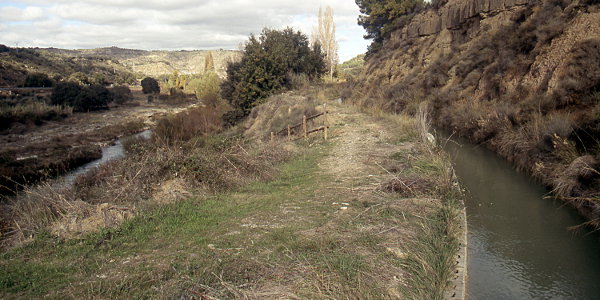
Huerta de Vero

Pictures: 26.XII.1995, 08.XI.2011


Pictures: 26.XII.1995, 08.XI.2011
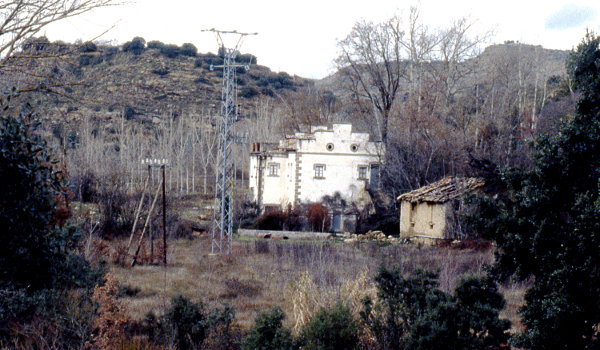

The original mill was probably housed in the smaller construction (1 & 3 right), but outside there was nothing hinting at its former purpose and I couldn't possibly enter.
The site has a long history and was at times important as supplier of electricity to the wider region.
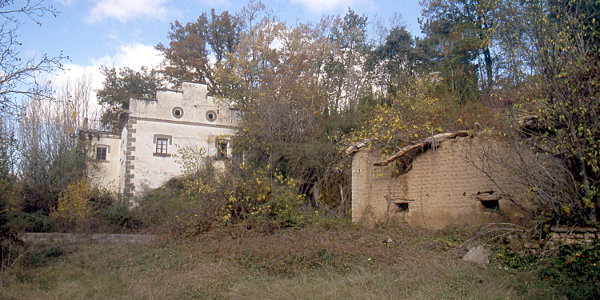
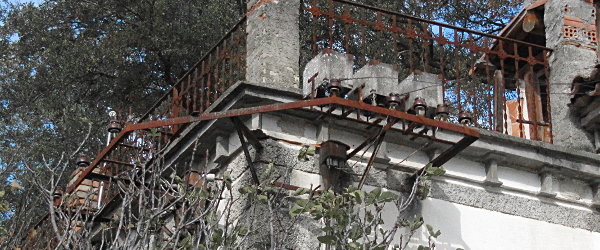
The other section of the grid runs northwards to Huerta de Vero and southwards to Azara where it branches to Azlor and Peraltilla.
In 2012 a local magazine (†) ran a story about electricity in Castillazuelo. Our mill is also mentioned and I will therefore give the relevant lines.
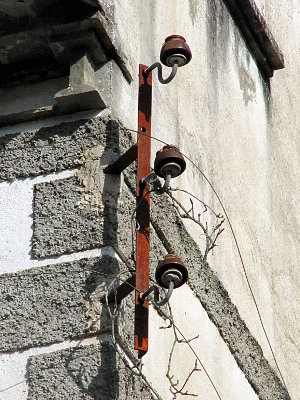

...
en Huerta de Vero, Mariano Lorenz Buera, labrador, nacido sobre 1867, está pensando en ampliar
su negocio. En 1900 vive en la calle la Iglesia número 29. Sabe leer y escribir. Su hermano
Manuel, tres años mayor, es el Alcalde. Mariano, en mayo de 1911, ya tiene el proyecto que
el ingeniero
industrial José Maluquer le ha diseñado para llevar la "luz eléctrica" a su
pueblo, Huerta de Vero, y a los vecinos de Azara, Azlor, Castillazuelo, Peraltilla, Pozán,
y el Monasterio de Nuestra Señora del Pueyo. Su ambicioso proyecto tiene un presupuesto de 25.850 pesetas (5).
Mariano aprovecha la fuerza de la turbina, de 40 caballos, del molino harinero de su propiedad, para mover un alternador de 30 kilovatios (5). La corriente alterna obtenida es elevada por un transformador hasta los 3.000 voltios para su distribución mediante líneas trifásicas (de tres conductores) para reducir las pérdidas. El transformador de Castillazuelo —para todo el pueblo— tiene 4 kilovatios. La línea del Pueyo se quedará en el tintero.
El 12 de octubre de 1912 una Real Orden le otorga a Mariano la concesión solicitada y a
los pocos días inicia las obras.
....
...
in Huerta de Vero, Mariano Lorenz Buera, a farmer born around 1867, is considering
an expansion of his business. It's the year 1900 and he lives at number 29 in the Church street.
He knows how to read and write. His brother, three years older, is the local Mayor.
In May 1911 already, Mariano had his plans ready. The project, designed by the
industrial engineer José Maluquer, was to bring electric light
to Mariano's village Huerta de Vero, to the people of Azara, Azlor, Castillazuelo, Peraltilla,
Pozán and also to the Monastery of Nuestra Señora del Pueyo.
The cost for this ambitious plan was estimated at 25 850 pesetas (5).
Mariano makes use of the turbine (40HP) of his own flour mill to drive an alternator of 30 KW. The alternating current is then transformed up to 3 000 Volt and distributed via three phase lines (3 wires that is) in order to reduce losses. The transformator of Castillazuelo has a capacity of 4 KW — for the entire village! The line to el Pueyo will never materialize.
On October 12, 1912, a Royal Order grants Mariano his concession and the work starts only a few days
later.
....
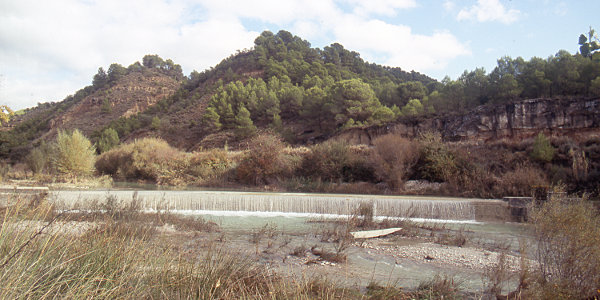
...
En 1929, los vecinos de Pozán denuncian el mal estado de la línea del pueblo.
En estos años las instalaciones y su mantenimiento son muy precarios y los cables están
muy cerca del suelo con el consiguiente peligro "para personas y caballerías" y también
para las labores del campo —como por ejemplo coger las olivas— por el peligro de tocar
con cañas, palos o incluso con el cuerpo al subirse a un árbol.
....
Mariano Lorenz cambia el nombre a su empresa y pasa a llamarse "Electra Lorenz". En 1931 inicia
los trámites para dar servicio a Buera (14).
El alumbrado para los particulares es muy caro —pero menos
que Joaniquet—
y por UNA bombilla (de 16 bujías) cobra, al mes, 2.50 pesetas. Este precio obliga a aprovechar
el único punto de luz y para ello se hacen esos huecos, encima de las puertas, que se ven
en algunas casas antiguas, para iluminar a los dos lados.
....
La guerra lo destroza todo —incluidas las notarías— y allí se pierde
la escritura de la venta, que en 1935, hace Mariano Lorenz junto a su hermano Manuel, de sus
derechos y la propiedad de las instalaciones y líneas a Felix Lalanne. Electra Lorenz
cambiará su denominación a "Hidroeléctrica de Huerta de Vero".
....
(5) AHPH (Archivo histórico provincial de Huesca), Obras públicas 148/55.
(14) AHPH, Obras públicas 190/221
...
In 1929, the people of Pozán denounced the poor state of
the line to their village (a). In those years the installations and their maintenance were most insufficient.
Moreover the lines were very close to the ground and posed a danger to people and horsemen
and also to people working on the fields. During the harvest of olives f.e. there was the risk of
hitting the lines with the poles used during this endeavour and people who climbed in a tree could
inadvertently touch live wires.
....
Mariano Lorenz changes the name of his company into Electra Lorenz. In 1931 he initiates
the procedures to service Buera (14). For private persons the tarifs are very steep at
2.50 pesetas a month for a SINGLE lightbulb of 16 candles — but Joaniquet (b)
charges even more (c).
Prices like this forced people to make the most of a single point of light.
They made holes in the wall, above the door, in order to give light to both sides. In some
old houses these holes can still be seen.
....
The war destroys everything —including notaries— and so the deeds of the sale
were lost, but in 1935 Mariano Lorenz and his brother Manuel sell the entire business to
Felix Lalanne (d). Electra Lorenz now becomes Hidroeléctrica de Huerta de Vero.
....
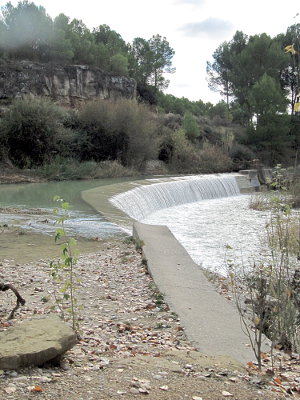
...
Hacia el año 25 se construyó la Central de la Luz, por
acciones (todos los vecinos del pueblo éramos socios, con más o menos acciones),
entonces tenia luz todo el pueblo, los más pudientes tenían cuatro ó seis
bombillas, nosotros teníamos una en la cocina y otra en el patio conmutadas.
...
Antes de la central, el pueblo se servia de la Luz del "Americano", que bajaba del Molino de Salas.
Pero esta luz solo la podian pagar los pudientes, lo demás nos alumbrábamos con candiles
de aceite y después de carburo ...
Around [19]25 the powerstation was built and shares issued (all villagers were partners with more or fewer shares). As a result all the people had light, the wealthy had four or six bulbs and we had one in the kitchen and another one in the courtyard commutated.Notice that there is a conflict between the years in both articles. In Zimbeler it was 1929 when the people of Pozán were not happy, but the website says Pozán got its own electricity already around 1925. Before that they got their light from the Americano (d). It was however not before 1935 that the Americano bought the business of the Lorenz brothers (†) unless it is true what Vicente Pinilla (☨) writes:
...
Before that electricity was delivered to the village from the mill of Salas (e), so called Light from the Americano (d) which only the rich could afford. We, the other people, used oil lamps and later carbide ...
Además en los años veinte construyó la central hidroeléctrica de Huerta de Vero que no solo suministró luz y energía a la bodega y casa familiar, sino a gran parte de la comarca.Weird however that no map shows the lines reaching the bodega and that there is a dam and a fábrica on the Río Vero just a few steps away.
Someone should clear this up.
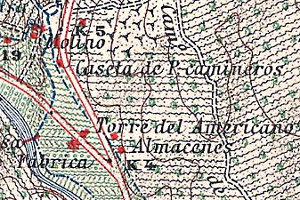
The website of the Bodegas Lalanne (IX.2016) explains that the domain was named Torre del Americano in honour of the rootstocks that were brought back from the Americas. I dare to question that. Félix (and later also his parents) came from America and he kept the Argentinian nationality up until his death. That is why I think that he is referred to as Americano and his chateau as Torre del Americano.
